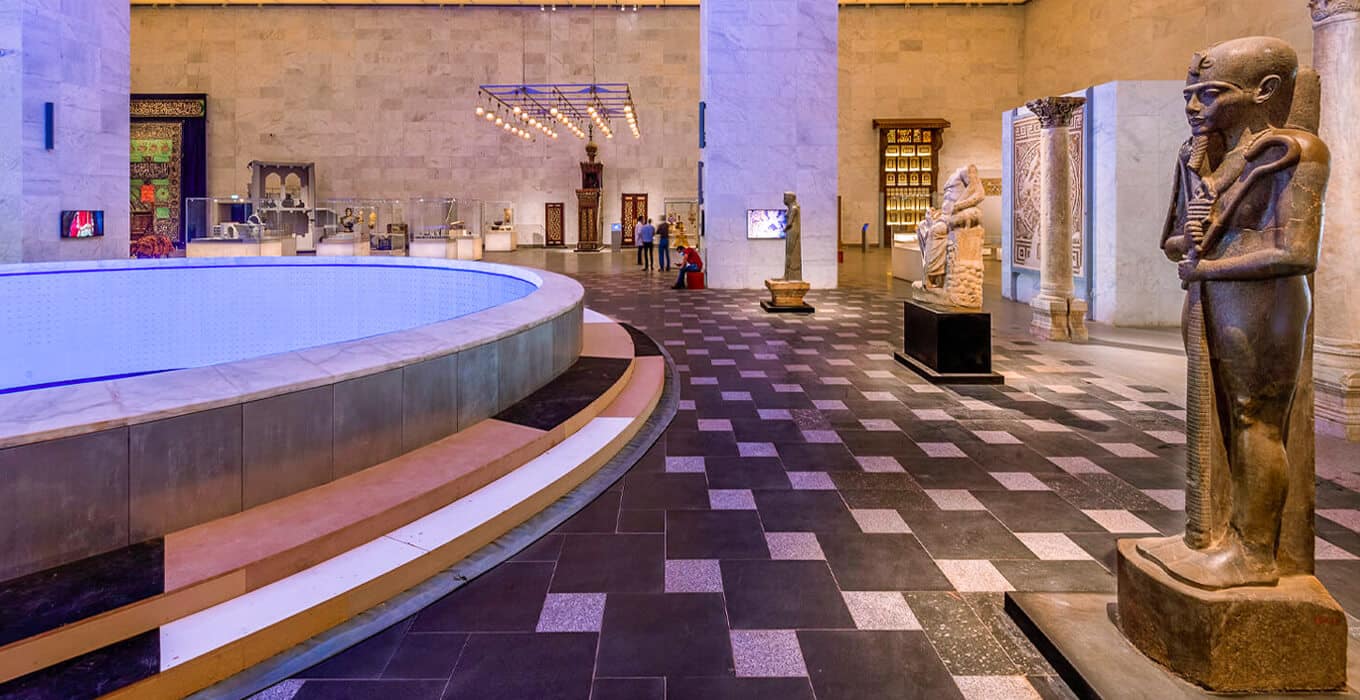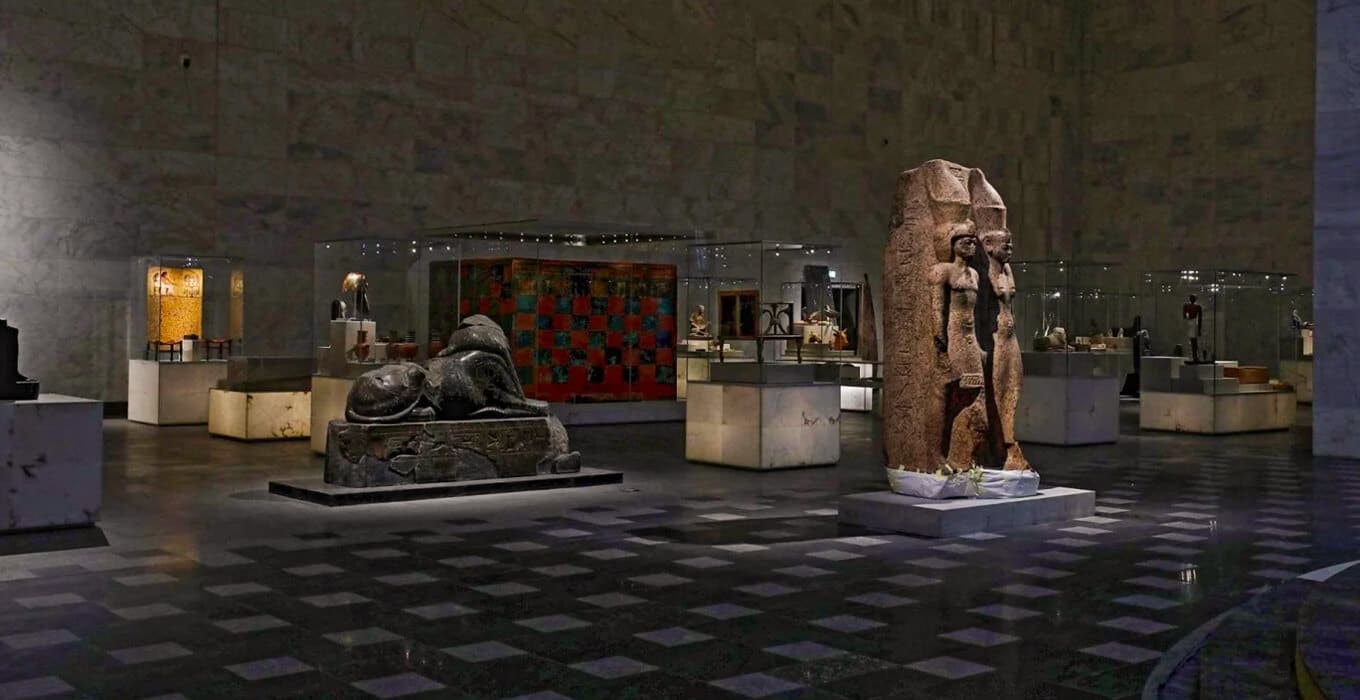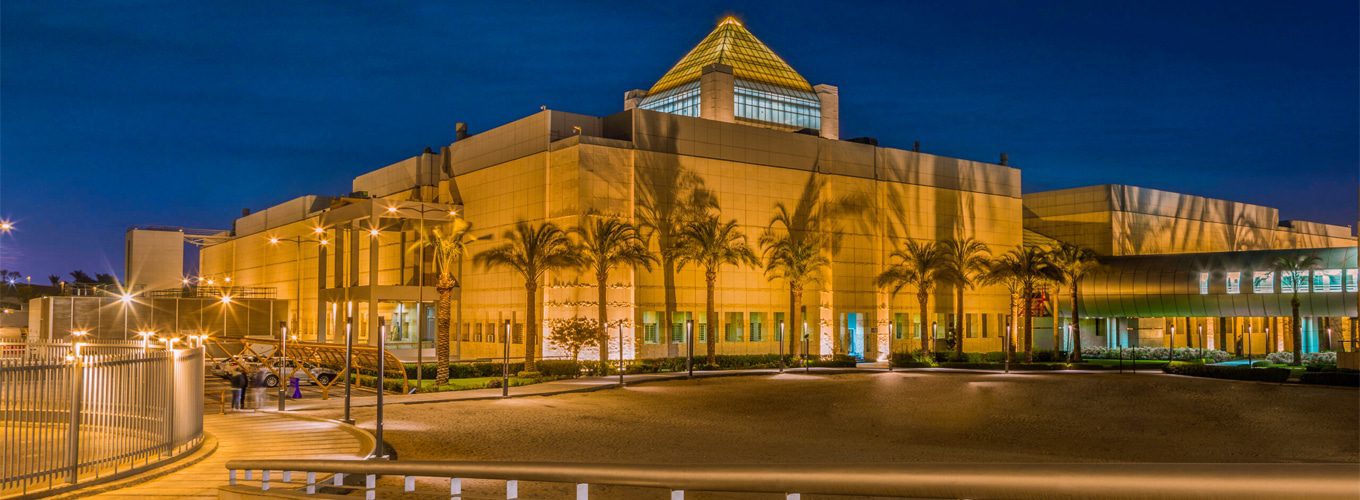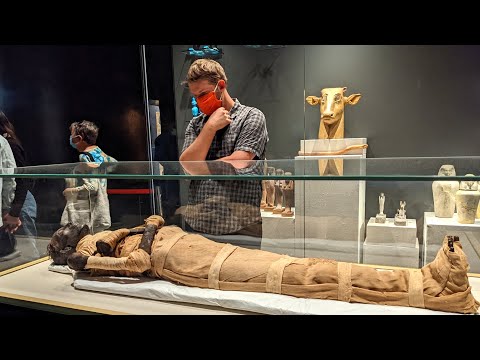Ever wondered what’s inside the National Museum of Egyptian Civilization (NMEC)? It’s in the heart of Cairo. This place shows off the lasting legacy of one of the world’s most interesting ancient cultures. Walk through its halls and start a journey through over 7,000 years of Egyptian history, from the very beginning to the Roman times.
The NMEC has more than 50,000 artifacts. They show the deep history and culture of Egypt. You’ll see everything from royal mummies to ancient crafts. Each item has a story that will grab your attention. This museum is a key place for learning about Egypt’s ancient and prehistoric times. It invites visitors to explore the secrets of ancient Egyptian history.
You can learn a lot about ancient Egyptian civilization through our page: Ancient Egyptian history
Key Takeaways
- The National Museum of Egyptian Civilization houses over 50,000 artifacts, offering a comprehensive look at 7,000 years of Egyptian history.
- Inaugurated in 2021, the museum is designed to preserve and showcase Egypt’s rich cultural legacy, from prehistoric times to the Roman era.
- The museum’s collection includes the transport of 22 royal mummies in a grand “Golden Parade of the Royal Mummies” event in 2021.
- The NMEC is a monumental architectural masterpiece that combines thematic and chronological exhibitions to immerse visitors in the evolution of Egyptian civilization.
- The museum serves as an educational and research hub, fostering knowledge and scholarship about Egypt’s remarkable past.
Unveiling Egypt’s Cultural Legacy
The National Museum of Egyptian Civilization (NMEC) is a key place for Egypt’s rich culture. It has historical artifacts, art, and objects. These items help visitors learn about Egypt’s history from ancient times to now.
Preserving Egypt’s Diverse Heritage
The NMEC has many items from different times in Egyptian history. It shows Egypt’s art and culture. The museum is important for keeping Egypt’s past safe for the future.

Promoting National Identity and Cultural Diplomacy
The NMEC does more than just preserve artifacts. It helps show Egypt’s national identity and cultural diplomacy. Through exhibits and working with other countries, it shares Egypt’s unique culture with the world.
This museum is a key place for learning about Egypt’s history and culture. It’s known as a major center for Egyptology. This field is very important for studying history, archaeology, and culture.
A Monumental Architectural Masterpiece
The National Museum of Egyptian Civilization is a true architectural wonder. It stands in the historic city of Fustat, the first Arab capital in Egypt. It overlooks the beautiful “Ain Al Sira” hot spring. The museum was designed from an international contest. Its design has become a famous landmark.
This museum is a modern and impressive structure. It’s located in a strategic spot, making it a top spot for tourists and architecture fans. It covers 33 acres and has over 50,000 artifacts. These artifacts show Egypt’s cultural growth from ancient times to now.
Visitors can see different historical periods like Ancient Egyptian, Greco-Roman, Coptic, Islamic, and Contemporary. The museum has special exhibitions and galleries for this. It also has modern facilities like an International Training Center and labs.
It has theaters, cafeterias, restaurants, and gift shops too. The NMEC offers a full experience for everyone. If you love history, architecture, or Egypt’s culture, this museum is a must-see. Plan your visit now and see the beauty of this architectural wonder.
Immersive Exhibitions and Galleries
The National Museum of Egyptian Civilization takes you on a deep dive into Egypt’s past. It has exhibitions and galleries that make you feel like you’re part of ancient Egypt. This museum brings the stories of the past to life.
Chronological Journey Through Egypt’s History
Visitors can follow the timeline of Egyptian history from the earliest times to now. You’ll see how ancient Egypt changed and grew over thousands of years. It’s a journey through time that shows the big steps forward in this ancient culture.
Thematic Explorations of Civilization
The museum also has special galleries that focus on certain parts of Egypt’s culture. You can learn about the Nile River, writing, social structures, and more. These galleries show how these things shaped Egyptian society.
With over 1,000 objects to see, the museum gives a full picture of Egyptian history and culture. It’s a place where you can learn a lot and have a great time exploring the secrets of ancient Egypt.
The National Museum of Egyptian Civilization
The National Museum of Egyptian Civilization (NMEC) has over 50,000 artifacts. They tell the story of Egyptian history from the beginning to now. The collection is split into two parts. One part covers time from prehistoric to modern days. The other part looks at different parts of Egyptian culture.
This museum is a key place to learn about ancient Egypt. Visitors can see how Egypt changed over time. They will be amazed by the artifacts and exhibits that show Egypt’s growth.
The museum was made by famous architects El Ghazzali Kosseiba and Arata Isozaki. Its design and modern spaces make visiting fun and interesting. You’ll see everything from old Pharaonic items to modern art. The National Museum of Egyptian Civilization is a great way to learn about Egypt’s culture.
“The National Museum of Egyptian Civilization is a testament to the enduring legacy of one of the world’s most remarkable civilizations, showcasing the remarkable achievements and artistic brilliance of ancient Egypt.”

The Royal Mummies: Resurrecting Ancient Rulers
The National Museum of Egyptian Civilization is full o
f Pharaonic history. It has a special collection of royal mummies. This collection includes 18 pharaohs and 4 queens, showing some of ancient Egypt’s most important figures.
Some of the rulers on display are Seqenenra Taa, Ahmose I, Ramses II, Hatshepsut, and Amenhotep III. Their stories have amazed people for thousands of years.
The Golden Parade: A Spectacle for the Ages
On April 3, 2021, a big event happened. The royal mummies moved from the Egyptian Museum in Cairo to the National Museum of Egyptian Civilization. This event was called the “Golden Parade of the Royal Mummies.”
The mummies were carried in golden coffins through streets of Cairo. The event had a 21-gun salute, dancers, and music. It was seen by people all over the world.
This move was important for Egypt’s culture. It was shown live on TV. It showed Egypt’s history in a big way.
“The parade symbolized a renaissance in Egypt, showcasing grandeur, pride, and divine celebration.”
The museum is now a key place for Egypt’s culture. It draws visitors with its exhibits and the royal mummies.
Exploring Contemporary Egypt
The National Museum of Egyptian Civilization (NMEC) is known for its ancient history. But it also shows off contemporary Egypt. It highlights the modern cultural and artistic achievements of Egyptians. This gives visitors a full view of Egypt’s growth and its role in the world today.
The museum has exhibits on modern Egyptian art like paintings, sculptures, and multimedia. These pieces show the diversity of modern Egyptian culture. They mix ancient traditions with new art trends. Visitors see how Egyptian artists and designers use their heritage in new ways.
The NMEC also talks about Egypt’s advancements in science, technology, and industry. It shows Egypt’s work in things like renewable energy, green buildings, and medical research. These efforts show Egypt’s progress and its effect on the world.
The museum shows Egypt’s past and present together. This gives a complete view of a nation that keeps changing and making a mark on the world. The museum invites visitors to see Egypt’s rich culture, from old to new.
Educational and Research Hub
The National Museum of Egyptian Civilization is more than a place to visit. It’s a key spot for learning and research. Scholars and researchers come here to study Egypt’s ancient past. They find a rich world of knowledge and resources.
The museum has over 50,000 artifacts. This makes it perfect for deep research and study. People from all over the world come to learn about Egypt’s culture. The museum has great exhibits and facilities for learning.
Fostering Knowledge and Scholarship
The museum does more than just show artifacts. It works with schools and research groups in Egypt and beyond. This helps share knowledge and ideas. The museum is a place where different fields come together to learn about Egypt’s history.
- The museum houses nearly 50,000 artifacts showcasing the development of Egyptian civilization from ancient times to the modern era.
- The NMEC offers a range of amenities and services, including parks, dining establishments, a center for handmade crafts, and retail stores, to enhance the visitor experience.
- The museum’s collection includes significant artifacts such as Prince Ptah Shepses’ belt, King Ramses II’s sarcophagus, and Negmenkh sarcophagus from the Ptolemaic era.
- The National Museum of Egyptian Civilization features interactive displays and 3D holograms to engage visitors and bring the country’s rich history to life.
The museum is both a cultural treasure and a place for learning. It shines as a center of knowledge. It helps us understand and explore Egypt’s lasting legacy.
Planning Your Visit
Planning a trip to the National Museum of Egyptian Civilization in Cairo, Egypt, is important. It’s open from Saturday to Thursday. On Fridays, it’s open from 6:00 pm to 9:00 pm. Sundays are closed.
For non-Egyptians, tickets cost 240 EGP for adults and 120 EGP for students. Egyptians pay 60 EGP for adults and 30 EGP for students.
Practical Information and Tips
Wear comfy clothes and be ready for cool air at the museum. It’s in the center of Cairo, close to other sights. You can get there by taxi, Uber, metro, or bus.
Cairo is a big city with over 22 million people. The Cairo International Airport (CAI) has flights to many places around the world.
If you’re coming from outside Egypt, you can get a tourist visa online. It lasts for 3 months. Or, you can get a visa when you arrive for 30 days for $25 in US dollars.
Tipping in Egypt is common. Leave 10% at cafes and restaurants. It’s good to tip drivers about £50LE a day and tour guides £100LE a day.
| Visitor Category | Admission Fee |
| Foreigners (Adults) | 500.00 LE |
| Foreigners (Students) | 250.00 LE |
| Arabs (Adults) | 500.00 LE |
| Arabs (Students) | 250.00 LE |
| Egyptians (Adults) | 80.00 LE |
| Egyptians (Students) | 40.00 LE |
Plan ahead for a great visit to the National Museum of Egyptian Civilization.
Conclusion
The National Museum of Egyptian Civilization in Cairo is a key place for Egypt’s culture. It has many ancient artifacts, art, and history. Visitors get to see Egypt’s past in a deep way.
This museum helps keep Egypt’s culture alive. It also helps people understand Egypt’s history and culture better. It’s a place for learning and sharing knowledge with the world.
The museum is known for its beautiful design and amazing exhibits. It shows the royal mummies and more. It’s a top spot for those who love ancient Egypt and its effects on the world.
The museum is dedicated to saving Egypt’s culture and history. It offers a full museum experience. It’s a key place for learning and research in Egyptology.
People from all over the world visit this museum. It helps share Egypt’s culture and identity. It’s a special place in Cairo that connects people globally.
Don’t miss our related article:

